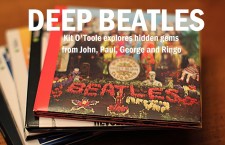As is well known to Beatles fans, Ringo Starr has professed a long-term love affair with country music. In 1965, he covered Buck Owens’ “Act Naturally,” only to rerecord it with the country singer in 1989. Starr’s first composition, “Don’t Pass Me By,” presented his take on the genre.
However, the Rubber Soul track “What Goes On” was penned not by Starr, but John Lennon. One of his initial compositions, Lennon wrote the track with later assistance from Paul McCartney, giving Starr a signature track he still performs in concert. It encapsulates Starr’s country leanings, but also gave George Harrison a chance to show how much Chet Atkins and Carl Perkins influenced his picking style.
Throughout the Beatles’ career, the group dabbled in country music. The 1964 release Beatles for Sale features several twangy covers and originals, including “I Don’t Want to Spoil the Party,” “Everybody’s Trying to be My Baby,” and “Honey Don’t.” Therefore, it was hardly a surprise that band would revisit the genre on Rubber Soul.
Lennon revealed in one of his final interviews that he composed “What Goes On” early in his career. “That was an early Lennon, written before the Beatles when we were the Quarrymen or something like that,” he recalled. “And resurrected with a middle-eight thrown in, probably with Paul’s help, to give Ringo a song … and also to use the bits, because I never liked to waste anything.” McCartney told Many Years from Now author Barry Miles that “What Goes On” was retooled for Starr, as the drummer had “a great style and great delivery.”
An early demo, a portion of which has surfaced online, suggests that the idea originated from Lennon. Interestingly, “What Goes On” remains the lone song to receive a Lennon-McCartney-Starkey credit, although Starr later told Miles that he contributed “about five words.”
According to Mark Lewisohn’s Complete Beatles Recording Sessions, the Beatles briefly considered “What Goes On” as a follow up single to “Please Please Me.” They were to record an early version on the track on March 5, 1963. but ran out of time that day.
Kenneth Womack points out in the Beatles Encyclopedia that McCartney provided Starr with an advance tape to study for the session. Recording occurred late in the Rubber Soul sessions on Thursday, November 4, 1965. Due to the time crunch — EMI wanted the album released in time for the lucrative Christmas season — the Beatles completed the track in one day.
McCartney’s bass and Starr’s drums were recorded in one take on track one. Next, Starr laid down his lead vocal on another track, Lennon and McCartney overdubbed backing vocals, and Lennon and Harrison added their rhythm and lead guitar parts, respectively.
Starr’s droll voice shines in “What Goes On,” his unique vocal range fitting the song perfectly. He delivers the lyrics in an almost conversational manner, casually observing that “the other day I saw you / As I walked along the road.” Upon realizing that his lover was with another man, he concludes that he could “feel my future fold.”
The chorus directly addresses the unfaithful woman, with Lennon and McCartney’s backing vocals underscoring Starr’s distress. “What goes on in your heart? / What goes on in your mind?” they harmonize. Starr cries that she is “tearing me apart / When you treat me so unkind.”
The song’s woeful tone transforms into anger during the final verses, with Starr declaring that “you were just the same” as everyone else, that “you didn’t even think of me / As someone with a name.” In a final putdown, Starr accuses her of breaking his heart and watching him die — a line that follows traditional country tropes.
In addition to Starr’s voice, Harrison’s lead guitar adds a country twang to “What Goes On.” His picking style recalls that of Atkins, one of Harrison’s chief influences. A pioneer in combining country and pop to create the “Nashville sound,” Atkins gained admiration for his skill in playing chords and melodies simultaneously using his thumb-and-three-finger picking style.
“One More Chance,” Atkins’ 1950 single with His Guitar Pickers, illustrates how he influenced Harrison’s style on “What Goes On.” To further demonstrate his fandom, Harrison performed the solo on none other than a Gretsch Chet Atkins Tennesseean.
One can also draw comparisons to Perkins; Harrison’s work resembles the guitar solo on the Beatles’ cover of Perkins’ “Everybody’s Trying to be My Baby.” McCartney’s walking bass also adds to the jaunty rhythm.
In addition to appearing on Rubber Soul, “What Goes On” was released as the b-side of the U.S. “Nowhere Man” single in February 1966. While not a huge hit, the b-side became a favorite among Starr fans — so much so that he added the track to his All-Starr Band setlist beginning in 2006.
“What Goes On” provides another example of how the Beatles incorporated various musical genres, but never simply copied them. Instead, they took elements of various music styles and infused them with their own lyricism and rock touches.
- How John Lennon Came Roaring Back on the Beatles’ White Album - November 22, 2023
- Five ‘With the Beatles’ Deep Cuts That Illustrate Their Lasting Debt to R&B - November 20, 2023
- Five Must-Hear Deep Cuts from the Beatles’ ‘Past Masters’ - March 7, 2023


